Ho Chi Minh Mausoleum: A Comprehensive Guide to Vietnam’s Iconic Landmark
Ho Chi Minh Mausoleum, tucked away in the center of Hanoi is a place of final resting of the most revered leader in the nation. Known by most as “Uncle Ho,” Ho Chi Minh guided Vietnam toward independence and significantly influenced the course of the country. This page, MOTOGO Tours, can help you on your visit to Ho Chi Minh Tomb.

Who is Ho Chi Minh?
Renowned in Vietnamese history, Ho Chi Minh is sometimes known as “Uncle Ho.” Leading Vietnam toward independence from French colonial control and subsequently in the fight against the United States, he was instrumental. He was much respected and loved for his leadership and relentless devotion to the Vietnamese people.
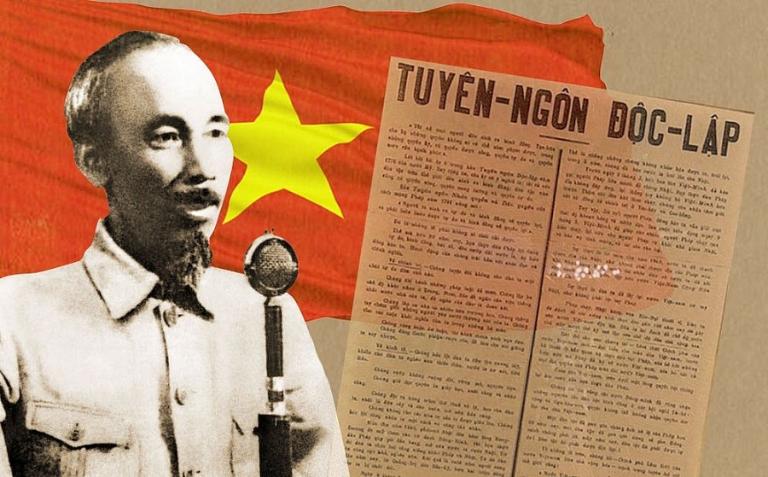
The Significance of Ho Chi Minh
- Independence Leader: Ho Chi Minh was the primary architect of Vietnamese independence. He founded the Indochinese Communist Party and the Viet Minh, a resistance movement that fought against French colonial rule.
- Nationalist Icon: Considered as a symbol of Vietnamese nationalism, he motivates the people to struggle for their sovereignty and freedom.
- Communist Leader: Ho Chi Minh, a fervent communist, sided Vietnam with the Soviet Union throughout the Cold War. His leadership and ideas helped to define Vietnam’s political and economic landscape.
- Humanitarian: Ho Chi Minh was renowned for his humanitarian activities notwithstanding his political philosophy. Particularly for the working class and rural populace, he promoted social justice and equality.
- Cultural Icon: Ho Chi Minh’s teachings and picture have become rather embedded in Vietnamese society. His publications and speeches are much sought after since he is usually shown as a smart and compassionate leader.
The History of the Ho Chi Minh Mausoleum
Built to honor and protect the body of Ho Chi Minh, the national renowned leader, the Ho Chi Minh Mausoleum is a well-known historical landmark in Hanoi, Vietnam. The political and cultural events that molded Vietnam in the 20th century entwine the mausoleum’s history.
The Decision to Preserve Ho Chi Minh’s Body
The Vietnamese authorities had to choose how to honor their dear leader following Ho Chi Minh’s passing in 1969. Ho Chi Minh had indicated his wish to be cremated and have his ashes scattered over the nation, but the government and people yearned to have his body preserved as a symbol of national unity and a site for next generations to honor.
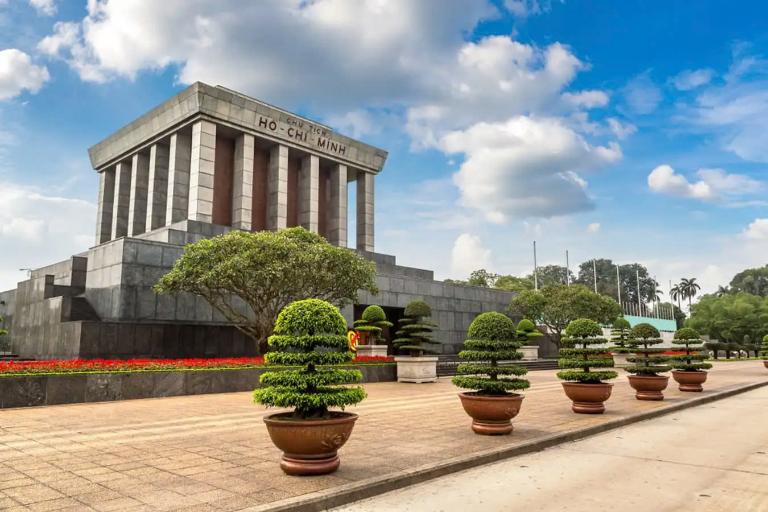
>>> Let’s see more: Thang Long Imperial Citadel: Explore Vietnam’s Timeless Heritage
Construction of the Mausoleum
Shortly after the Vietnam War ended, in September 1973, building of the mausoleum started. Inspired by Lenin’s Mausoleum in Moscow, the design included adaptations reflecting Vietnamese architectural tastes and cultural preferences. Granite was used to build the tomb; it is a strong, timeless substance.
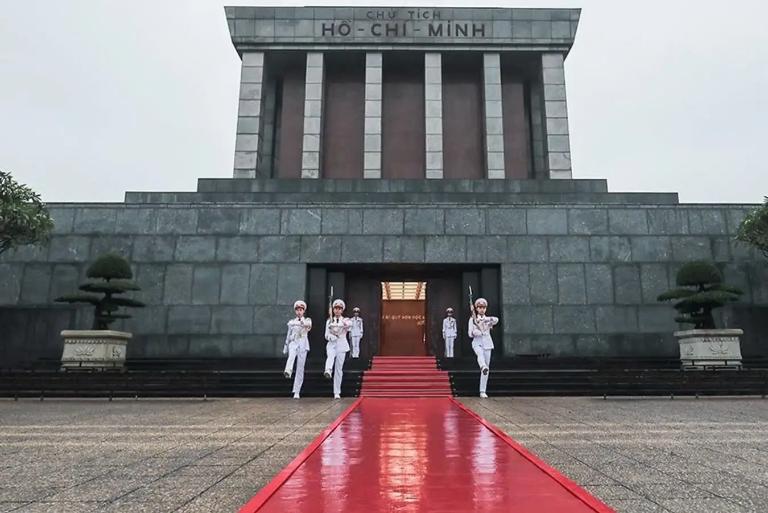
Inauguration and Public Access
Officially opening on August 29, 1975, the Ho Chi Minh Mausoleum marks Ho Chi Minh’s second anniversary of death. It was opened to the public right away, letting people from all walks of life pay their respects to the founding father of their country.

>> Articles for you: Temple of Literature | A Timeless Tribute to Vietnamese Education
The Architectural of the Ho Chi Minh Mausoleum
Stunning architectural wonder, Ho Chi Minh Mausoleum in Hanoi is evidence of the respect the country has for its revered leader. Rising to a height of 21.6 meters, the solid square block of three levels spans 41.2 meters width. Built to last, it’s meant to endure floods, bombings, even a 7.5 magnitude earthquake.
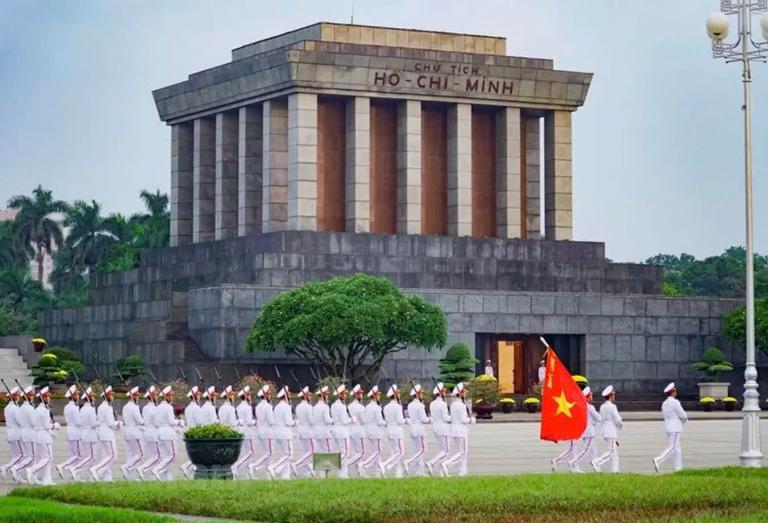
Gray granite covers the outside, framed by tasteful marble columns. On top of the tomb, “CHỦ TỊCH HỒ – CHÍ – MINH,” is engraved in red jade stone. A tribute to the great natural legacy of the country, the 200 sets of doors are made from rare timbers acquired from all over.
Red and pink marble adorns the foyer, creating an arresting backdrop for the gold-plated signature of President Ho Chi Minh and the slogan “Không có gì quý hơn Độc lập Tự do” (Nothing is more precious than Independence and Freedom). Two troops standing guard at the door have hourly shifts that serve as continual reminder of the legacy of the leader.
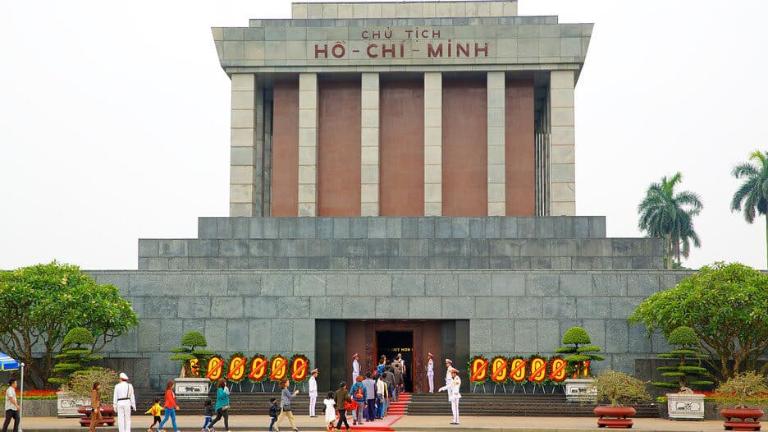
Inside, the tomb boasts a central chamber displaying Ho Chi Minh’s embalmed body. This chamber is kept dark to preserve the body and uphold the gloomy mood. Ho Chi Minh can be seen by guests in the room thanks to a glass coffin that keeps a respectful distance. Four men on duty in the room guarantee the continuous vigilance.
The surrounds of the tomb are equally striking as the building itself. Comprising more than 250 varieties of plants, the location is surrounded by a rich green scene. Every tree and bloom has particular meaning related to the events and memories of President Ho Chi Minh during his lifetime.
>> Let’s explore together: Explore Hoa Lo Prison: A Dark Chapter of Vietnam War
Essential information for tourists visiting Ho Chi Minh Mausoleum
The address of Ho Chi Minh Mausoleum
Right in the middle of Ba Dinh Square is the famed Ho Chi Minh Mausoleum in Hanoi. Easily reachable by both private and public transportation, the tomb is situated at 2 Hung Vuong, Dien Bien Ward, Ba Dinh District.
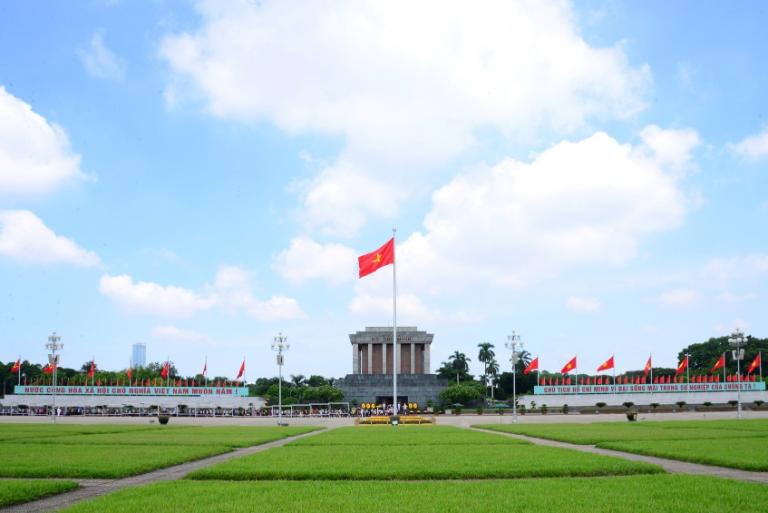
Getting There:
- Private Vehicle: Should you be riding or driving a motorbike, you can park at the assigned locations on Ngoc Ha Street (the entrance to Ho Chi Minh Museum) or Ong Ich Khiem Street (opposite the Mausoleum Guard Command).
- Public Transportation: Routes 09, 33, 22, 45, or 50—which pass Ba Dinh Square—offer a handy bus ride.
- In addition, to enhance your experience, you can choose guided tours like Hanoi Motorbike Tours. They will provide a comprehensive overview of Ho Chi Minh Mausoleum’s history and significance
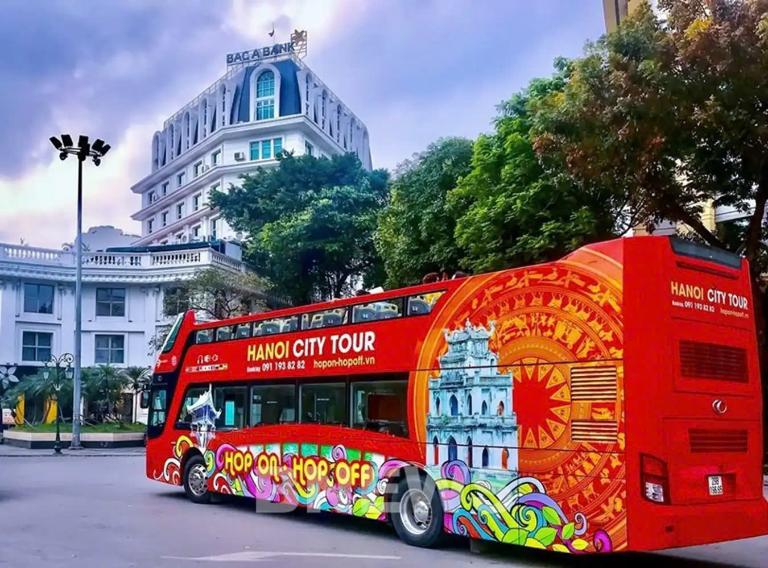
Entrance to the Ho Chi Minh Mausoleum pay merely VND 25,000 (about US$ 1.07). This little charge presents a great chance to honor a national hero and explore Vietnam’s rich past. For such a huge experience, the cost is a minor one.
Ho Chi Minh Mausoleum Visiting Hours
The Ho Chi Minh Mausoleum is open to the public on Tuesdays, Wednesdays, Thursdays, Saturdays, and Sundays. Please note that the mausoleum is closed to visitors on Mondays and Fridays, as well as in the afternoons of the aforementioned days. Except for May 19th, September 2nd, and the first day of the Lunar New Year, which will always be available to the public regardless of the day of the week, though.
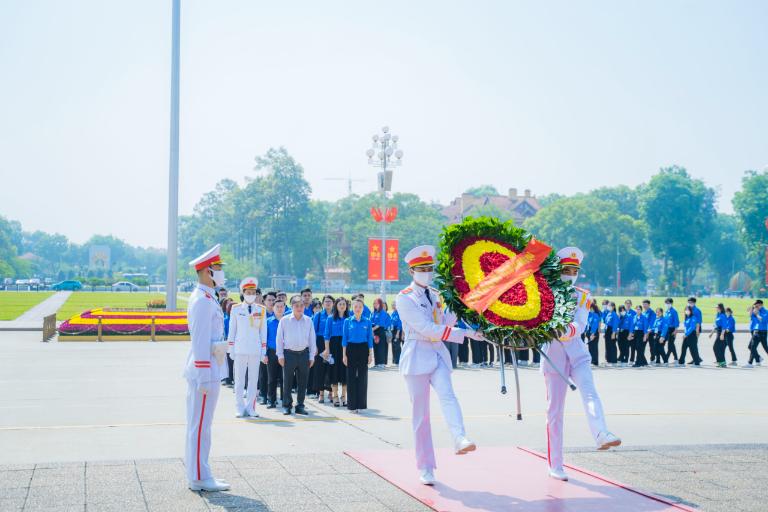
The tomb closes for roughly two months every year to help to preserve President Ho Chi Minh’s body. Usually, this runs between September and November. The Mausoleum Management Board releases an official calendar for these closures ahead of time.
The specific visiting hours for the Ho Chi Minh Mausoleum are as follows:
- Summer & Fall (April 1 – October 31): Tuesday – Thursday and Saturday – Sunday, 7:30 AM – 10:30 AM
- Winter & Spring (November 1 – March 31): Tuesday – Thursday and Saturday – Sunday, 8:00 AM – 11:00 AM
- On Saturdays, Sundays, and public holidays, the visiting hours are extended by 30 minutes.
Plan your visit to Ba Dinh Square to see daily flag-raising and lowering ceremonies at 6 AM and 9 PM for a unique encounter. These events help you to better appreciate Vietnam by providing a great window into its history and culture.
>>> Let’s see more: Hanoi Old Quarter: A Journey Through Time and Culture
Ho Chi Minh Mausoleum’s rules
Please observe these rules to guarantee a courteous and significant visit to the Ho Chi Minh Mausoleum:
- Attire: Dress modestly and formally. Avoid casual attire such as shorts, sandals, or sleeveless shirts.
- Security: Pass through the security checkpoint and deposit your belongings as instructed.
- Order: Maintain an orderly queue, following the directions of the staff. Avoid pushing or disrupting the line.
- Respect: Remove your hat and hold it in your right hand. Refrain from making noise or touching the walls. Keep your hands out of your pockets.
- Photography: If you wish to take photos or videos in the area, please follow the instructions of the on-duty officers.
- Prohibitions: Photography, filming, or sketching of the chamber containing President Ho Chi Minh’s embalmed body is strictly prohibited.
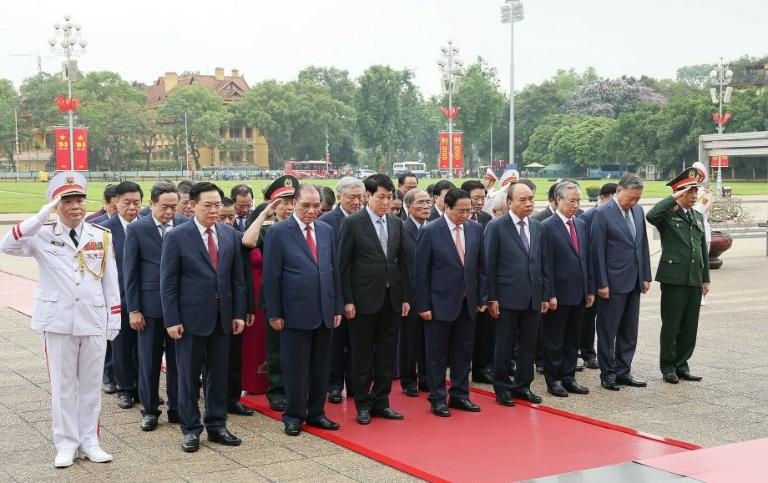
Exploring the Ho Chi Minh Mausoleum Complex: Beyond the Mausoleum
Offering guests a rich dive into Uncle Ho’s life and legacy, the Ho Chi Minh Mausoleum Complex is a treasure store of Vietnamese history. Though the tomb itself is a must-see, the site also features several other intriguing attractions:
One Pillar Pagoda
Built originally in 1049, the One Pillar Pagoda is a symbol of Vietnamese resiliency. Towering atop a lake fashioned like a lotus, its unusual form embodies the serenity and beauty of the nation. Though destroyed by French soldiers, Uncle Ho oversaw rebuilding of it in 1955.

Presidential Palace
Once the residence of the French Indochina Governor, Presidential Palace provides a window into the colonial age. Although Ho Chi Minh turned down to live in such a lavish environment, it provided a stage for significant interactions and visits from young Vietnamese youngsters.
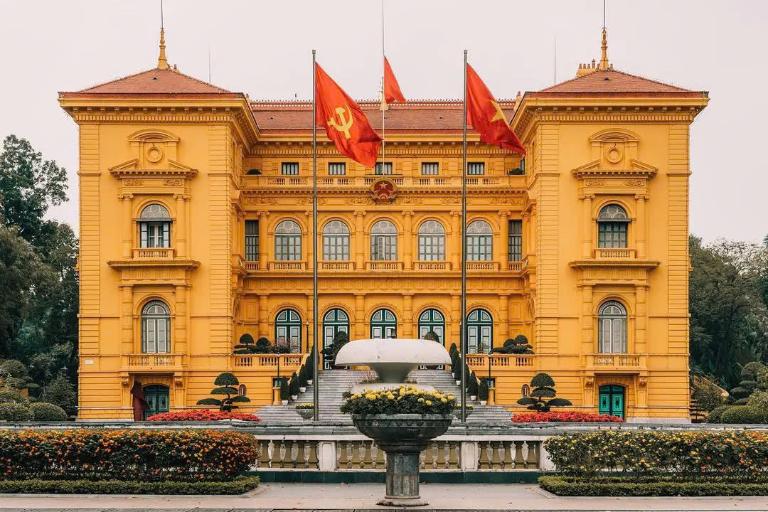
Ho Chi Minh Museum
Modern marvel, the three-story Ho Chi Minh Museum is fashioned like a big white flower. It displays a great array of historical relics and chronicles Uncle Ho’s life and the Vietnamese revolution.
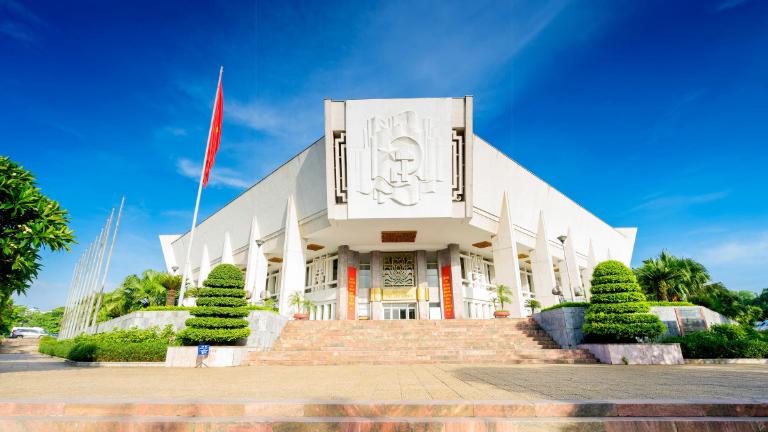
House No. 54
For four years Ho Chi Minh lived in this little dwelling. Understated and basic, it captures the leader’s modest way of life. From the furnishings to the kitchen tools, every object in the house was a gift from supporters all around.
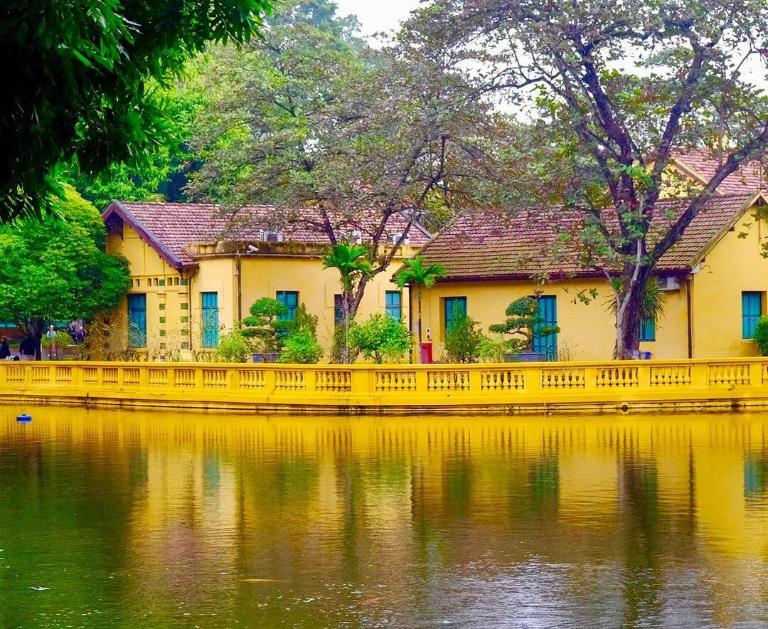
Ho Chi Minh’s House on Stilts
Designed to be like northern Vietnam’s stilt homes, this last home of Ho Chi Minh provides a window into his modest life. Nestled among fish ponds and rich vegetation, the villa exudes calm and harmony.

One amazing monument bearing evidence of the life and legacy of a great leader is the Ho Chi Minh Mausoleum. For everyone fascinated in Vietnamese history and culture, it is absolutely must-see. Seeing the mausoleum will help you to better appreciate the history of the country and the ongoing spirit of its people.
Related Posts:
- The Bat Trang Pottery Village: A Must-visit Destination in Hanoi
- St. Joseph’s Cathedral: Hanoi’s Gothic Masterpiece and Cultural Icon
- Tran Quoc Pagoda: Hanoi’s Oldest and Most Revered Buddhist Site
- Thang Long Water Puppet Theatre: Hanoi’s Cultural Masterpiece
- Discover the Vietnamese National Museum of History: A Journey Through Time










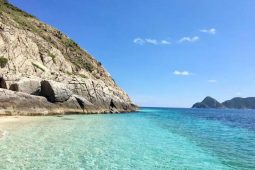

Be the first to comment!